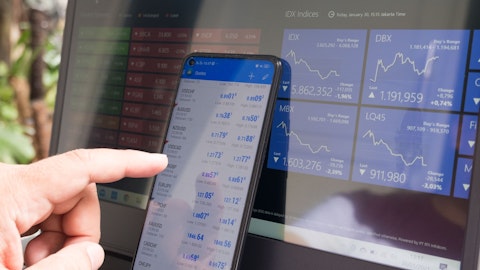Nokia Oyj (NYSE:NOK) Q4 2023 Earnings Call Transcript January 25, 2024
Nokia Oyj isn’t one of the 30 most popular stocks among hedge funds at the end of the third quarter (see the details here).
David Mulholland: Good morning, ladies and gentlemen. Welcome to Nokia’s Fourth Quarter 2023 Results Call. I’m David Mulholland, Head of Nokia Investor Relations. And today with me is Pekka Lundmark, our President and CEO; along with Marco Wiren, our CFO. Before we get started, a quick disclaimer. During this call, we will be making forward-looking statements regarding our future business and financial performance and these statements are predictions that involve risks and uncertainties. Actual results may therefore differ materially from the results we currently expect. Factors that could cause such differences can be both external as well as internal operating factors. We have identified such risks in the Risk Factors section of our annual report on Form 20-F, which is available on our Investor Relations website.
Within today’s presentation, references to growth rates will mostly be on a constant currency growth rate basis and where we refer to margins, it will be based on our comparable reporting. Please note that our Q4 report and a presentation that accompanies this call are published on our website. The report includes both reported and comparable financial results and a reconciliation between the two. With that complete, in terms of the agenda for today, Pekka will give an overview on the quarter and then Marco will give into a bit more detail on some of the key factors impacting our financial performance before Pekka gives a brief conclusion when we move to Q&A. With that, let me hand over to Pekka.

Pekka Lundmark: Thank you, David and thank you to everyone for joining us today. So, let me start with an update on some of the strategic and operational changes we announced with our Q3 results in October. We are evolving our operational model to give our business groups increased autonomy and have now embedded our sales teams into the business groups. This announcement has been well received by our customers. We have hit the ground running in 2024 to embed sales teams into the business groups happened at the start of the year. We have appointed customer account executives and the country manager role has also been reinforced. The customer account executives are there to ensure that we still offer one point of contact and person responsible for overall relationship management with customers without detracting from the accountability of the business groups.
Some corporate functions have also moved to the business groups as we move to a leaner corporate center. During first half of 2024, we will begin reporting business group regional sales and cash flow metrics to further enhance transparency. And we already commenced the process of resetting our cost base during 2023. We expect this program will generate EUR 400 million of gross savings during 2024. If we then turn to Q4 and 2023 full year we, of course, saw a meaningful shift in customer behavior impacting our industry. This was driven by macroeconomic environment and high interest rates along with customer inventory digestion especially in North America. This led to our fourth quarter sales declined by 21% and full year sales declined by 8% in constant currency.
Proactive action across our organization meant we were able to protect our profitability, while continuing to invest in R&D, and we delivered a comparable operating margin of 14.8% in Q4 and 10.7% for the full year. This was a resilient performance considering the challenging environment and lower contribution from our high-margin patent licensing business as some renewals remained outstanding. We were pleased with our cash performance in the quarter where we generated €1.7 billion of free cash flow and we ended the year with a net cash balance of €4.3 billion. Positively, we also ended the year with improving order intake. Our fourth quarter book-to-bill was above one, particularly supported by our network infrastructure business, indicating at least some improvement in the overall spending environment.
See also 30 Best Selling Yankee Candle Scents and Alternatives and 12 High Growth Monthly Dividend Stocks to Buy.
Q&A Session
Follow Nokia Corp (NYSE:NOK)
Follow Nokia Corp (NYSE:NOK)
Moving on to Network Infrastructure. Sales declined by 24% in constant currency versus the year-ago quarter, which had been particularly strong. For the full year, sales declined by 9%, mainly, driven by IP and Fixed Networks, optical networks grew by 5% and ASM declined slightly. There was a favorable development in gross margin, which impacted by improved by 60 basis points versus the year ago quarter and by 130 basis points for the full year, and this was driven by positive product mix. Operating margin in the quarter decreased to 13.9% due to the impact of lower sales. For the year, our — ended up at 13.1%, which was comfortably within the range we had shared at the beginning of the year and above the targets we had set for ourselves back in 2021.
As you remember, we had Capital Markets Day back then where we set the targets for each of the business in 2023. Also, if I can give you a quick update on the profitability of each of the units within NI for the full year in 2023, IP Networks saw its profitability declined slightly due to the weaker sales coverage, but remains mid to high-teens operating margin. Optical networks improved strongly benefiting from the sales growth to deliver a high single-digit operating margin. For fixed networks, despite the sales decline, product mix was beneficial and delivered high-teens operating margin. And finally, submarine networks remained low single-digit, but did improve slightly year-over-year. Mobile Networks Q4 saw the continued impact of normalization of India rollout and the dual impact of inventory digestion and macroeconomic pressure spending in North America.
We were, however, pleased to see a robust gross margin performance supported by favorable regional and product mix in Q4. Similarly, operating margin for the quarter was 11.5%, an improvement of 470 basis points versus the year ago quarter, driven by gross margin and lower variable pay accruals. For the full year, in spite of top-line challenges, operating margin was 7.4%, which was within our stated planning assumption for the year and at the higher end of our targets we set back in 2021. Finally, on Mobile Networks, AT&T’s recent announcement to move to a largely single-source radio network was, of course, a disappointing development. As we said at our investor event in December, and as confirmed by AT&T, this does not reflect the technological competitiveness that we have achieved with our products.
This has been evidenced by our significant increase in rent market share in recent years. I firmly believe Mobile Networks has the right strategy in place to create value for our shareholders in the future with opportunities to gain share, diversify our business and achieve a double-digit operating margin longer term. CNS sales declined in Q4 by 5%, driven by declines in all businesses with the exception of business applications, which grew. Gross margin improved, and this flowed through to operating margin and the full year improved from 5.3% to 7.9%. The 7.9% operating margin, we delivered is at the higher end of what we targeted at the start of the year. It is slightly below the lower end of what we had set as target back in 2021. This is due to the increased investments we decided to make in private wireless, which has been consistently delivering double-digit growth.
2023, did see us making progress in our portfolio rebalancing efforts with the divestment of VitalQIP, the announced sale of our device management and service management platforms businesses in December and the partnership we announced with Red Hat on cloud infrastructure. We also led the industry trend towards programmable networks with the launch of our network as code platform which now has nine commercial agreements. Nokia Technologies net sales decreased 63% on both the reported and constant currency basis in the fourth quarter as the year-ago quarter had a €305 million one-off non-cash benefit we explained at the time. Excluding this, the year-on-year net sales performance primarily reflected lower net sales from a license that expired at the end of the third quarter 2023.
The financial performance in 2023 was, of course, not what we had hoped for as some deals took longer to renew than we had expected. There were still some very important achievements. We signed long-term renewals with both Apple and Samsung, along with signing a new agreement with Honor. Positively, as we, of course, announced yesterday, we have now achieved a renewal with Oppo. And we are very close to concluding another agreement in China. With these agreements, we are now in the final stages of our smartphone license renewal cycle with only the recently expired major agreement outstanding. This provides long-term stability to our Nokia Technologies business, which can now increasingly focus on growing our licensing run rate in the new growth areas, including automotive, consumer electronics, IoT and multimedia.
I remain confident that with growth in these areas, we can return to an annual net sales run rate of €1.4 billion to €1.5 billion in Nokia Technologies in the mid-term. Enterprise net sales decreased 3% in constant currency in Q4 in comparison to a very strong year ago quarter. However, for the full year, we grew 16%, which shows strong continued momentum. Overall, customer engagement also remains strong as we added 151 new enterprise customers in the quarter. Private wireless continued to show strong growth in 2023 and now has more than 710 customers. You can also see on the right-hand side of this slide, a breakdown of the €2.3 billion of enterprise sales we had in 2023. We wanted to give a bit more color around the components of our enterprise business.
Almost half of our enterprise sales come from areas where we sell our NI products into targeted enterprise verticals, particularly those that value mission-critical networks. Private wireless is now just over one-quarter of our enterprise sales having grown strongly for several years and then web scale is an increasingly important opportunity for us as well. Now I will hand over to Marco to go through the financials in more detail.





